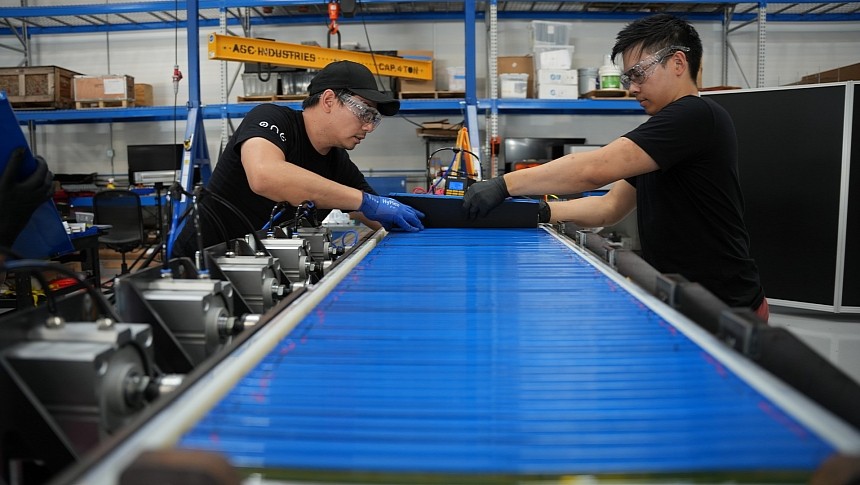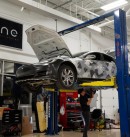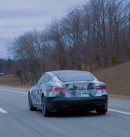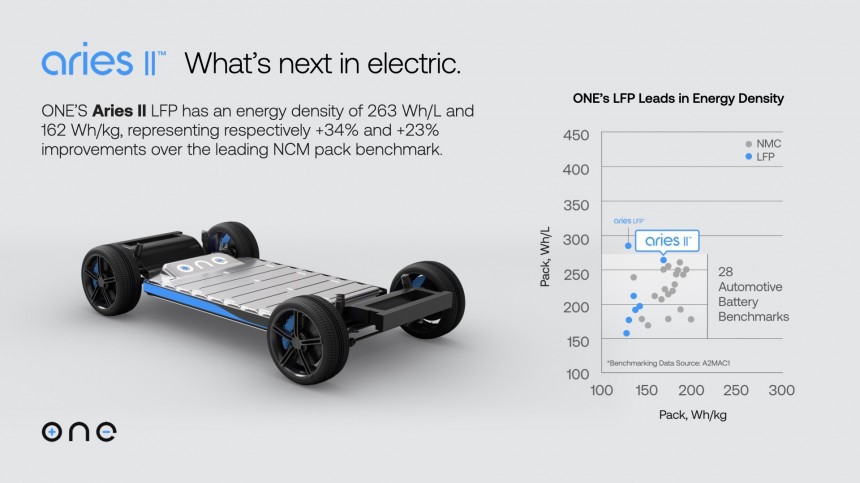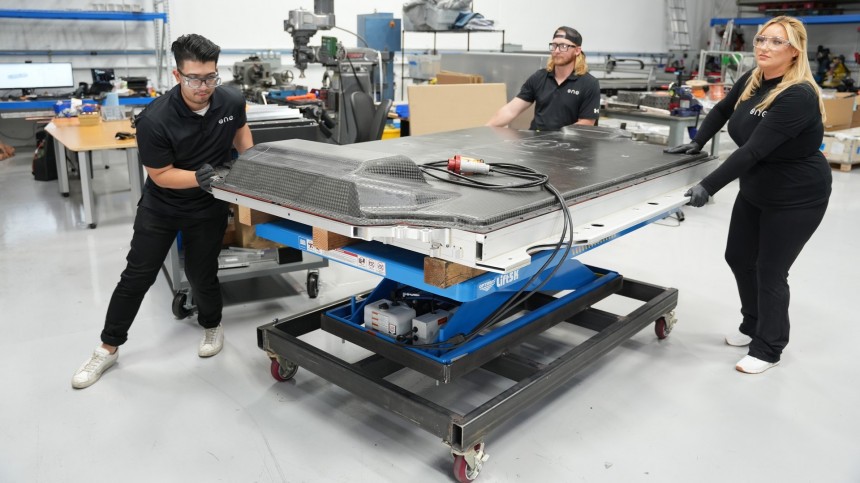Ternary cells – such as NMC or NCA – have a higher energy density than those made with lithium iron phosphate (LFP). That does not mean that a battery pack with ternary batteries will have a higher energy density at the pack level than LFP units. Our Next Energy (ONE) helped us reinforce that with the Aries II, which presents a volumetric energy density of 263 Wh/L and a gravimetric energy density of 162 Wh/kg. Those figures match those from NMC or NCA battery packs, but this should surprise nobody.
LFP cells can also work as structural elements in a car, which allows cell-to-pack (CTP) or even cell-to-body (CTB) construction methods. Battery packs with these properties have a higher cell-to-pack mass ratio compared to those using cylindrical lithium-ion batteries. Automakers like Tesla prefer them because they are cheaper and faster to make than prismatic cells. Yet, they force battery packs to present a lot of material that does not store electricity. This is what lowers the energy density disadvantage that LFP batteries have at the cell level.
BatteryDesign created a list of battery packs with the higher and lowest energy densities, and the world leader comes from NIO. With 150 kWh and 575 kilograms (1,268 pounds), it delivers 260.9 Wh/kg. That's way more than the 162 Wh/kg of the Aries II, but how does it compare to the Tesla Model Y and its 4680 cells? It beats it.
The 445-kg battery pack offers 71.5 kWh, which translates into a gravimetric energy density of 160.7 Wh/kg at the pack level. The only battery pack from Tesla that wins a comparison with the Aries II is the one with 82 kWh on the Tesla Model 3 and Model Y: it has an energy density of 171 Wh/kg. Tesla told the EPA that it had 165 Wh/kg in a September 2020 document. The list does not include the Model S/Model X battery pack.
If you are wondering about the Porsche Taycan, the 2019 Turbo S derivative has a 93.4-kWh battery pack that weighs 630 kg (1,389 lb). That corresponds to a gravimetric energy density of 148.3 Wh/kg. Things get worse when you consider the usable energy of the battery packs. As I have no idea if ONE is talking about the total or usable energy, let's keep the numbers just like that.
It is a pity that BatteryDesign did not include BYD products in its list, so I had a look at the company's numbers, and the Aries II does much better than the Blade Batteries. The first vehicle to use them was the Han EV, which has an 85.4-kWh battery pack that tips the scale at 592 kg (1,305 lb). That's 144.2 Wh/kg at the pack level, which makes the battery pack from ONE a better option.
The BYD Dolphin has two battery pack options. The largest one presents 44.9 kWh and the best energy density for its mass (308.6 kg, or 680 lb): 145.5 Wh/kg. The Seal should theoretically be the best vehicle in energy-density terms. Its CTB construction made the battery pack weigh 558 kg (1,230.2 lb) and hold 82.56 kWh. Its gravimetric energy density increases a bit more: 148 Wh/kg. That's close to what Taycan's high-voltage accumulator delivers for chemistry that is considered much safer. ONE said it is also 25% cheaper, but its main advantage may be that it has to be charged to 100% of its capacity frequently and lasts much longer than ternary cells.
Compared to BYD's battery packs, the disadvantage that Aries II presents is that the Chinese goods are already for sale. The battery pack produced by ONE will only leave production lines by the end of 2024. Neither the battery manufacturer nor any carmaker has disclosed the Aries II will power any passenger vehicle. The only company that informed it would have ONE's products was Bollinger, but they will be the Aries LFP, not the Aries II. The Aries LFP is for Class 3 to Class 6 trucks and can stand 3,000 cycles, while the Aries II is for passenger cars and light trucks. Its durability is 33.3% shorter, with a lifespan of 2,000 cycles. ONE did not clarify why they present these differences.
The edge ONE has over several competitors is local production. That will make any vehicles that use its products and fits the Inflation Reduction Act (IRA) limits eligible for full tax credits. It is also an American company, not a Chinese, Japanese, or Korean one producing in the US with foreign technology. That may only appeal to marketing folks: as long as the batteries are American-made and comply with the IRA, automakers will go with the supplier that presents the best costs, including being close to the factories that will need these components. ONE will make them in Van Buren Township, Michigan, pretty close to Ford, General Motors, and Stellantis factories.
BatteryDesign created a list of battery packs with the higher and lowest energy densities, and the world leader comes from NIO. With 150 kWh and 575 kilograms (1,268 pounds), it delivers 260.9 Wh/kg. That's way more than the 162 Wh/kg of the Aries II, but how does it compare to the Tesla Model Y and its 4680 cells? It beats it.
The 445-kg battery pack offers 71.5 kWh, which translates into a gravimetric energy density of 160.7 Wh/kg at the pack level. The only battery pack from Tesla that wins a comparison with the Aries II is the one with 82 kWh on the Tesla Model 3 and Model Y: it has an energy density of 171 Wh/kg. Tesla told the EPA that it had 165 Wh/kg in a September 2020 document. The list does not include the Model S/Model X battery pack.
It is a pity that BatteryDesign did not include BYD products in its list, so I had a look at the company's numbers, and the Aries II does much better than the Blade Batteries. The first vehicle to use them was the Han EV, which has an 85.4-kWh battery pack that tips the scale at 592 kg (1,305 lb). That's 144.2 Wh/kg at the pack level, which makes the battery pack from ONE a better option.
The BYD Dolphin has two battery pack options. The largest one presents 44.9 kWh and the best energy density for its mass (308.6 kg, or 680 lb): 145.5 Wh/kg. The Seal should theoretically be the best vehicle in energy-density terms. Its CTB construction made the battery pack weigh 558 kg (1,230.2 lb) and hold 82.56 kWh. Its gravimetric energy density increases a bit more: 148 Wh/kg. That's close to what Taycan's high-voltage accumulator delivers for chemistry that is considered much safer. ONE said it is also 25% cheaper, but its main advantage may be that it has to be charged to 100% of its capacity frequently and lasts much longer than ternary cells.
The edge ONE has over several competitors is local production. That will make any vehicles that use its products and fits the Inflation Reduction Act (IRA) limits eligible for full tax credits. It is also an American company, not a Chinese, Japanese, or Korean one producing in the US with foreign technology. That may only appeal to marketing folks: as long as the batteries are American-made and comply with the IRA, automakers will go with the supplier that presents the best costs, including being close to the factories that will need these components. ONE will make them in Van Buren Township, Michigan, pretty close to Ford, General Motors, and Stellantis factories.
